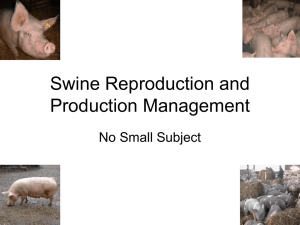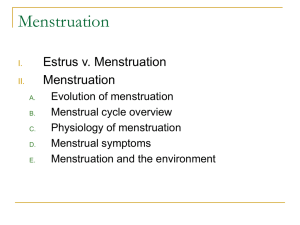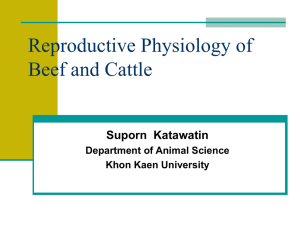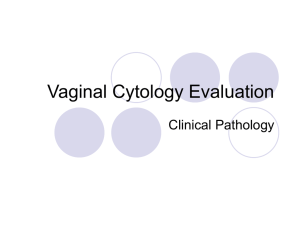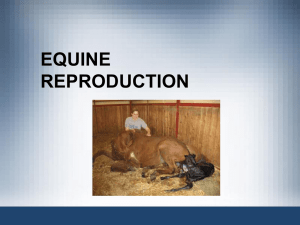FIELD EVALUATION OF AUTOMATED ESTRUS DETECTION
advertisement
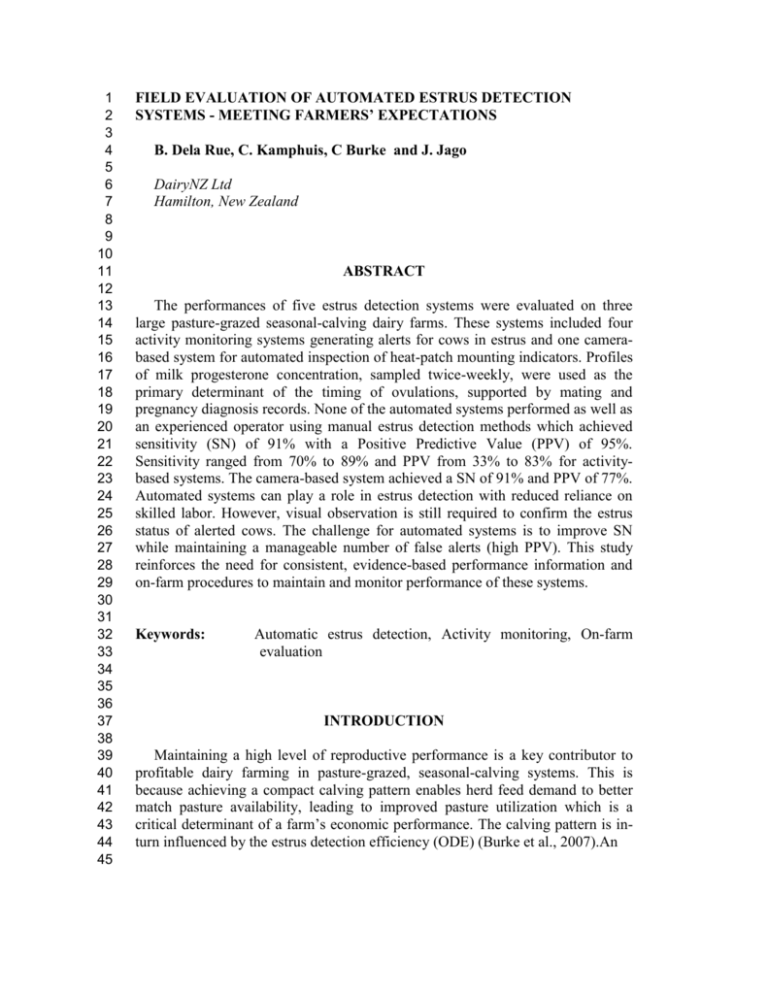
1 2 3 4 5 6 7 8 9 10 11 12 13 14 15 16 17 18 19 20 21 22 23 24 25 26 27 28 29 30 31 32 33 34 35 36 37 38 39 40 41 42 43 44 45 FIELD EVALUATION OF AUTOMATED ESTRUS DETECTION SYSTEMS - MEETING FARMERS’ EXPECTATIONS B. Dela Rue, C. Kamphuis, C Burke and J. Jago DairyNZ Ltd Hamilton, New Zealand ABSTRACT The performances of five estrus detection systems were evaluated on three large pasture-grazed seasonal-calving dairy farms. These systems included four activity monitoring systems generating alerts for cows in estrus and one camerabased system for automated inspection of heat-patch mounting indicators. Profiles of milk progesterone concentration, sampled twice-weekly, were used as the primary determinant of the timing of ovulations, supported by mating and pregnancy diagnosis records. None of the automated systems performed as well as an experienced operator using manual estrus detection methods which achieved sensitivity (SN) of 91% with a Positive Predictive Value (PPV) of 95%. Sensitivity ranged from 70% to 89% and PPV from 33% to 83% for activitybased systems. The camera-based system achieved a SN of 91% and PPV of 77%. Automated systems can play a role in estrus detection with reduced reliance on skilled labor. However, visual observation is still required to confirm the estrus status of alerted cows. The challenge for automated systems is to improve SN while maintaining a manageable number of false alerts (high PPV). This study reinforces the need for consistent, evidence-based performance information and on-farm procedures to maintain and monitor performance of these systems. Keywords: Automatic estrus detection, Activity monitoring, On-farm evaluation INTRODUCTION Maintaining a high level of reproductive performance is a key contributor to profitable dairy farming in pasture-grazed, seasonal-calving systems. This is because achieving a compact calving pattern enables herd feed demand to better match pasture availability, leading to improved pasture utilization which is a critical determinant of a farm’s economic performance. The calving pattern is inturn influenced by the estrus detection efficiency (ODE) (Burke et al., 2007).An 1 2 3 4 5 6 7 8 9 10 11 12 13 14 15 16 17 18 19 20 21 22 23 24 25 26 27 28 29 30 31 32 33 34 35 36 37 38 39 40 41 42 43 44 45 46 47 48 economic model predicts that, for a 400-cow herd, there is a benefit of NZ$867 (~US$695) for every 1% increase in ODE (Burke et al., 2008). The most common method of estrus detection is visual observation of estrusrelated cow behavior, supported by mounting indicators such as tail-paint (Macmillan and Curnow, 1977) or heat patches (Cavalieri et. al., 2003). However, estrus detection by visual observation is considered to be one of the most labor intensive and skilled tasks required of dairy farmers (Blackwell et al., 2010; Harris et al., 2010). In addition, the increasing reliance on less skilled labor and larger herd sizes (Taylor et al., 2009; Newman, 2011) puts improving or maintaining current levels of reproductive performance at risk. In response, New Zealand farmers have expressed interest in automated estrus detection, although, only around 1% of farms are currently using these systems (Cuthbert, 2008). Farmer’s expectations of automated estrus detection are reported to be that the system should eliminate or reduce labor while performing to the industry target reproductive performance levels or at least to their own current detection level using visual observation (Burke et al., 2007). The ODE on large, pasture-grazed farms is estimated to average 88% (ranging from 78% to 94%; C. Burke, personal communication). However, ODE is an estimate based on mating records and may differ from results where progesterone concentrations are used as a gold-standard to determine when ovulation occurs. It is suggested that only around 90% of ovulations can be detected using tail-paint as an estrus detection aid (Diskin and Sreenan, 2000). There have been a number of studies reporting on the performance of automated estrus detection systems, almost exclusively using activity monitoring systems. They include studies in housed systems (De Mol et al., 1997; At-Taras and Spahr, 2001; Roelofs et al., 2005) and in pasture-grazed systems (Xu et al., 1998; Verkerk et al., 2001; McGowan et al., 2007; Sakaguchi et al., 2007; Hockey et al., 2010; Kamphuis et al., 2012). Unfortunately, it is difficult to compare the results between studies or with on-farm visual detection performance, as the methods of measurement and analysis differ between studies and few have been conducted on the scale of commercial grazing herds. Evidence-based information on the field performance of these systems is necessary to support farmer investment decisions. This paper summarizes the performance of five estrus detection systems evaluated in three studies on large pasture-grazed seasonalcalving dairy farms between 2008 and 2010. These systems included four activity monitoring systems and one camera-based heat patch system. All systems were evaluated using the same methodology. The performance of an experienced farmer was assessed to provide an industry relevant benchmark. MATERIALS AND METHODS Farms and estrus detection technologies Farm 1 is a University-owned commercial dairy farm milking 670 springcalving, pasture-grazed cows. The standard procedure for estrus detection is visual observation of tail-paint over the 37 days of artificial insemination (AI). Two automated estrus detection systems were installed and operational over the 1 2 3 4 5 6 7 8 9 10 11 12 13 14 15 16 17 18 19 20 21 22 23 24 25 26 27 28 29 30 31 32 33 34 35 36 37 38 39 40 41 42 43 44 45 46 47 48 AI period of 2010/11 season. The first system included two different models (Activity devices 1 and 2) of a commercially-available activity monitoring system using collar-mounted accelerometer-based devices. Data were available for 315 cows fitted with Activity device 1 and for 320 cows fitted with Activity device 2. Activity data were captured at each AM and PM milking and estrus alerts were recorded in accordance with the normal procedure for the system. The activity alert threshold was set at the suppliers recommended value (default value) and data were not disclosed to farm staff. The second automated estrus detection system was a camera-based system for automated inspection of heat patches that were applied to all cows in the herd (in addition to tail-paint) as the mounting indicator. This recently developed system was in limited commercial release at the time of the study. Digital images of the heat patch were automatically captured at each milking and assessed for degree of color change in the heat patch using the detection system’s image analysis algorithm. The heat patch assessment is normally completed by the system in real-time so cows can be alerted and drafted at the end of milking, but the assessment was done retrospectively in this study. The threshold for color change in the heat patch that determined an estrus alert was set by the supplier. The performance of the farmer was assessed using the farm AI mating records and pregnancy outcomes. Farm 2 was a commercial dairy farm milking 700 spring-calving, pasturegrazed cows. An activity system with collar-mounted pedometers (Activity device 3) was already in use for estrus detection and the alerts from the system were used in conjunction with visual observation of tail-paint. The activity alert threshold had been set by the farmer, based on experience with the system in previous years. The cows were managed in two herds, but for practical reasons only one herd, the mature cows (≥4 years) and 20 heifers from the second herd, were included in the study. Data from the first 3 weeks of AI were analyzed. Activity alerts were analysed independently of the farmer’s visual observations (not recorded). Farm 3 milked 560 spring-calving, pasture-grazed cows and used an activity system with leg-mounted pedometers (Activity device 4) for estrus detection. Only the mature cow herd was included in the study and only the first three weeks of AI mating were analysed. The farmer set the alert threshold for the automated detection system and selection of cows for insemination was almost exclusively based on this automated heat detection system. Evaluation protocol The methods used to evaluate the five automated systems are described in detail by Kamphuis et al. (2012). In short, progesterone concentration profiles were constructed from milk samples collected twice weekly from all cows, and a trough-like curve in the progesterone profile was taken as evidence of an ovulation. An estrus date was assigned within this trough using the following prioritized decision rules: (1) the date of artificial insemination (AI) where this had resulted in conception as confirmed by pregnancy diagnosis, (2) the date of an unsuccessful AI where it corresponded with the nadir of the progesterone trough, (3) the date of an activity alert where it corresponds with the nadir of the progesterone trough, (4) the date that best matches the nadir of the progesterone 1 2 3 4 5 6 7 8 9 10 11 12 13 14 15 16 17 18 19 20 21 22 23 24 25 26 27 28 29 30 31 32 33 34 35 36 37 38 39 40 41 42 43 trough when no other supporting evidence was available. Further rules applying to first ovulations where the trough in the progesterone profile was not evident were also applied (Kamphuis et al., 2012). A 72 h time-window, within which alerts from the detection system were considered valid, was set around the insemination decision point (AM milking) on the estrus date to allow for potential inaccuracy in the setting of the estrus date. This 72 h time-window extended from 48 h hours before to 24 h after the end of the AM milking. A systems’ estrus alert generated within the 72 h time-window was considered a true positive (TP) alert. Multiple alerts occurring within the time-window were treated as a single alert, and each alert occurring outside the 72 h time-window were considered as false positives (FP) alert. The five automated detection systems were evaluated for their sensitivity (SN) and their positive predictive value (PPV) at the system default alert threshold for Farm 1 and the farmer-set alert thresholds for Farms 2 and 3. Sensitivity is the number of TP alerts as a proportion of the total number of gold-standard positive estrus events. It is calculated as SN = TP/(TP+FN)*100, where FN is the number of false negative alerts where a gold-standard positive estrus event received no alert from the system within the 72 h time-window. The PPV is a measure of the accuracy of the recorded alerts and is calculated as the number of TP alerts as a proportion of the total number of alerts (PPV = TP/ (TP+FP) *100). The effects of changing the activity threshold value on the relationship between SN and PPV were explored by plotting SN and PPV levels against varying threshold values on the x-axis. In addition, the PPV of all four activity systems was also calculated at a fixed SN of 80% to allow direct comparison between these systems. RESULTS The performances of the five automated detection systems are presented along with that of an experienced farmer using visual observation to identify cows in estrus (Table 1). None of the automated systems performed as well as an experienced operator using visual observation of tail paint as an estrus detection method (91% SN, 95% PPV). The SN of heat patches (Farm 1, SN = 91%) examined by image processing matched that of the experienced farmer but the PPV value was lower (77%), indicating more FP alerts compared with the farmer’s visual detection. On the same farm, the performances of the two activity devices were lower than both the farmer and the heat patch camera. Activity device 2 performed better than device 1 and when compared at 80% SN, the PPV value was more than double (values in brackets, Table 1). The best performing activity system was Activity device 4 on Farm 3 (89% SN, 83% PPV) which was similar to that of the heat patch camera. Fig. 1 reports on the trade-off between SN and PPV over a range of alert threshold values for Activity device 2. The x-axis shows the alert threshold value that can be set by the farmer. The x-axis values will differ between detection system as the units of measure for the alert threshold values are not consistent (e.g. % or standard deviation change in a 10-day rolling mean) between systems. The performance values at this system’s default alert threshold (5.2 on the x-axis, marked with a large arrow) are indicated by the dotted lines at 77% SN and 82% PPV. Sensitivity (%) 5 6 7 8 9 10 11 12 13 14 Table 1. Sensitivity (SN) and positive predictive value (PPV) for five automated estrus detection systems and one experienced farmer using visual observation, evaluated on three pasture-grazed, spring-calving commercial farms. Performance indicators Estrus Duration Detection Trial events SN PPV (weeks) method (#) (%) (%) visual observation farm 1 5 835 91 95 heat patch camera 782 91 77 1 activity device 1 415 62 (80) 77 (34) activity device 2 420 77 (80) 82 (75) farm 2 3 activity device 3 343 70 (80) 33 (27) farm 3 3 activity device 4 195 89 (80) 83 (89) 1 ( ) denotes performance calculated at 80% SN. 100 90 80 70 60 50 40 30 20 10 0 100 90 80 70 60 50 40 30 20 10 0 2 3 4 5 6 7 8 9 Positive Predictive value (%) 1 2 3 4 10 Detection system alert threshold value 15 16 17 18 19 20 Fig. 1. Effect of changing the alert threshold value (x-axis, vertical dashed line with large black arrow) on sensitivity (primary y-axis, black curve) and positive predictive value (secondary y-axis, grey curve) using Activity device 2 on Farm 1. Using the default alert threshold value of 5.2 results in a SN of 77% with a PPV of 82%. 1 2 3 4 5 6 7 8 9 10 11 12 13 14 15 16 17 18 19 20 21 22 23 24 25 26 27 28 29 30 31 32 33 34 35 36 37 38 39 40 41 42 43 44 45 It can be seen that SN of the system can be improved by lowering the alert threshold (a shift to the left on the x-axis), but this will also result in a decrease in PPV. A lower PPV means that there will be more FP alerts. Fig. 1 can be used to determine alert threshold settings that give the best combination of SN and PPV for the farmer, noting that different farmers are likely to have different tolerance levels for FP alerts. DISCUSSION Farmers’ expectations are that automated estrus detection systems should perform to industry targets or at least to their own current detection level using manual methods (Burke et al., 2007). These expectations are supported by anecdotal reports from some technology suppliers and early adopters of these automated systems that suggest that they do perform as well as or better than manual systems. However, none of the five automated estrus detection systems evaluated in these studies performed as well as the experienced farmer on Farm 1 (91% SN, 95% PPV). Two systems; the camera-based heat patch system and Activity device 4, did performed above the minimum performance target of 80% SN with 80% PPV suggested by Kamphuis et al.(2012) and Activity device 2 was just under this target. Performance may be improved in practice with the use of activity and mating records to filter some FP alerts. The results reported in this study are from single farm studies for each system and should, therefore, be considered as indicative of the system performances. CONCLUDING REMARKS Automated systems can play a role in estrus detection with reduced reliance on skilled labor. However, the results suggest the challenge for these systems is to improve SN while maintaining a manageable number of FP alerts (high PPV). Farmers may be prepared to accept a lower PPV as a trade-off to achieve higher SN with these systems. The range in performance between similar activity devices reinforces the need for consistent, evidence-based performance information to be available to farmers considering automated systems. While performance information is of critical importance for investment decisions, farmers must also consider the compatibility of the system with their own operational style, and the complexity of the system in relation to the relevant skill level on-farm. ACKNOWLEDGEMENT This paper was funded by the New Zealand Ministry of Primary Industries, Primary Growth Partnership and by DairyNZ Inc on behalf of New Zealand dairy farmers (Project SY1006). 1 2 3 4 5 6 REFERENCES At-Taras, E. E., and S. L. Spahr. 2001. Detection and characterization of estrus in dairy cattle with an electronic heatmount detector and an electronic activity tag. J. Dairy Sci. 84: 792-798. 7 8 9 10 11 12 13 14 15 Blackwell M.B, C.R. Burke, and G.A. Verkerk. 2010. Reproductive management practices in New Zealand dairy farm: what will the future hold in a consumerfocused, export-driven marketplace? Proceedings of the 4th Australasian Dairy Science Symposium, p 406-416. 16 17 18 19 20 Burke C.R, R. Tiddy, P.C. Beukes. 2008. Case studies exploring the potential impact of farm system changes on herd reproductive performance, production and profitability. Proceedings of the Dairy Cattle Veterinarians Conference, 268:25-33 21 22 23 24 Cavalieri, J., Eagles, V., Ryan, M. and K. Macmillan. (2003), Comparison of four methods for detection of oestrus in dairy cows with resynchronised oestrous cycles. Australian Veterinary Journal, 81: 422–425. 25 26 27 Cuthbert, S. 2008. DairyNZ milking practices and technology use survey. Page 40 in Report prepared for DairyNZ. LIC, Hamilton, New Zealand. 28 29 30 31 De Mol, R. M., G. H. Kroeze, J. M. F. H. Achten, K. Maatje, and W. Rossing. 1997. Results of a multivariate approach to automated oestrus and mastitis detection. Livest. Prod. Sci. 48: 219-227. 32 33 34 Diskin, M. G., and J. M. Sreenan. 2000. Expression and detection of oestrus in cattle. Reproduction Nutrition Development. 40: 481-491. 35 36 37 38 39 40 Harris, B. L., K. Hempstalk, B. Dela Rue, J. Jago, and J. E. McGowan. 2010. Improving the power of activity-based heat detection using additional automatically captured data. Pages 299-302 in Proc. of the New Zealand Society of Animal Production. R. Sumner, ed. Print House, Hamilton, New Zealand. Burke, C. R., M. Blackwell, and S. Little (eds.). 2007. Page 79 In The InCalf book for New Zealand Dairy Farmers. DairyNZ, Hamilton, New Zealand. 1 2 3 4 5 Hockey, C. D., J. M. Morton, S. T. Norman, and M. R. McGowan. 2010. Evaluation of a Neck Mounted 2-Hourly Activity Meter System for Detecting Cows About to Ovulate in Two Paddock-Based Australian Dairy Herds. Repr. Dom. Anim. 45: p107-117. 6 7 8 9 Kamphuis, C., B. Dela Rue, C. R. Burke. J. Jago. 2012. Field evaluation of 2 collar-mounted activity meters for detecting cows in estrus on a large pasturegrazed dairy farm. Journal of Dairy Science. In press. 10 11 12 MacMillan, K. L., and R. J. Curnow. 1977. Tail painting - a simple form of oestrus detection in New Zealand dairy herds. NZ. J. Exp. Agri. 5: 357-361. 13 14 15 16 17 18 McGowan, J. E., C. R. Burke, and J. G. Jago. 2007. Validation of a technology for objectively measuring behaviour in dairy cows and its application for oestrus detection. Pages 136-142 In Proc. of the New Zealand Society of Animal Production. G.K. Barrell (ed.), The Caxton Press, Christchurch, New Zealand. 19 20 21 Newman, M. (ed.). 2011. DairyNZ Economic Survey 2009-10. DairyNZ Limited, Newstead, New Zealand. 22 23 24 25 Roelofs, J. B., F. J. C. M. Van Eerdenburg, N. M. Soede, and B. Kemp. 2005. Pedometer readings for estrus detection and as predictor for time of ovulation in dairy cattle. Theriogen. 64: 1690-1703. 26 27 28 29 30 Sakaguchi, M., R. Fujiki, K. Yabuuchi, Y. Takahashi, and M. Aoki. 2007. Reliability of estrus detection in Holstein heifers using a radiotelemetric pedometer located on the neck or legs under different rearing conditions. Repro.Develop. 53: 819-828. 31 32 33 34 Taylor G, van der Sande L, Douglas R. 2009. Smarter not harder: Improving labour productivity in the primary sector. Technical Report. DairyNZ, Hamilton, New Zealand. 35 36 37 38 39 Verkerk, G. A., R. W. Claycomb, V. K. Taufa, P. Copeman, A. Napper, and E. Kolver. 2001. CowtrakkerTM technology for improved heat detection. Pages 172-175 In Proc. of the New Zealand Society of Animal Production. S.W. Peterson, ed. Design Centre The Printery, Palmerston North, New Zealand. 1 2 3 Xu, Z. Z., D. J. McKnight, R. Vishwanath, C. J. Pitt, and L. J. Burton. 1998. Estrus detection using radiotelemetry or visual observation and tail painting for dairy cows on pasture. J. Dairy Sci. 81: 2890-2896.
